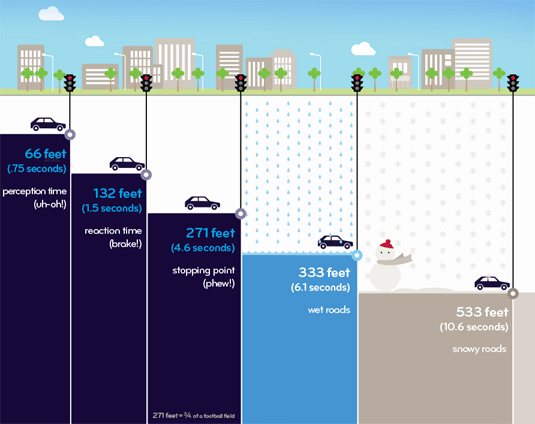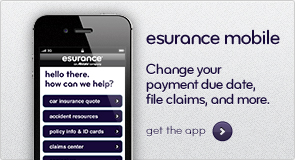|
|

|
|
|

|
|
|
|
When it comes to staying safe on the road, leaving enough following distance can make the difference between a near miss and an oh-no. How much room do you need?
You probably learned the 3-second rule in driver training, but, depending on speed, road conditions, and your reaction time, 3 seconds might not always be enough.
How stopping distance works
To figure out a safe following distance, it helps to know how long it takes to go from 60 to 0.
 For a car with decent brakes and tires in normal road conditions, stopping (from 60 mph) takes roughly 4.6 seconds. Add rain or snow to the mix and you need even more time because wet surfaces reduce friction, making it hard for your tires to grip and slow down. And, of course, the faster you drive, the more following distance you need.
For a car with decent brakes and tires in normal road conditions, stopping (from 60 mph) takes roughly 4.6 seconds. Add rain or snow to the mix and you need even more time because wet surfaces reduce friction, making it hard for your tires to grip and slow down. And, of course, the faster you drive, the more following distance you need.
How much following distance you need
Given that it takes more than 4 seconds to come to a complete stop, following the 3-second rule could put you at risk.
When driving at freeway speeds, AAA recommends that you give yourself a cushion of 4 seconds. If the roads are slick with rain or slushy with snow, give yourself a cushion of 6 or more seconds.


|
|
How would you rate this article?
|
Not helpful
|

|

|

|

|

|
Very helpful
|
|

|
|
|
|
|
|
|

|
|
|
|

|
|

|
|
|
|
|
|
 With the Affordable Care Act making headlines, chances are you're wondering how health care reform could affect you.
With the Affordable Care Act making headlines, chances are you're wondering how health care reform could affect you.
While the changes are vast, impacting everyone from employers to health care providers, we've culled 3 things to help you get started.

|
Beginning January 1, 2014, everyone must have health insurance. If you can afford health insurance and choose not to buy coverage, you'll have to pay a fee and all of your health care costs.
The fee is small at first — either one percent of your annual household income or $95, whichever is greater — but will increase every year. In 2015, expect to pay 2 percent or $325 per person. And, in 2016, it will jump to 2.5 percent or $695 per person.
|
|

|
If you want to use the Health Insurance Marketplace, you can only do so during open enrollment, which lasts from October 1, 2013 to March 31, 2014. At that time, you'll be able to get broader coverage, lower costs, and health care even if you have a pre-existing condition.
|
|

|
You don't have to use the Health Insurance Marketplace. The Marketplace, the government-sponsored shopping hub, is open to everyone. While you can use it to apply for insurance, you're not required to.
|
Though we've done our best to simplify a complex topic, it's always a good idea to determine how these changes might affect you and your family at healthcare.gov.
If you're looking for more health insurance options or just want to see if you can save big with other providers, we can help. Get a free health insurance quote to compare plans and apply for the policy that suits you best.


|
|
How would you rate this article?
|
Not helpful
|

|

|

|

|

|
Very helpful
|
|

|
|
|
|
|
|
|

|
|
|
|
Apple and the Apple logo are trademarks of Apple Inc., registered in the U.S. and other countries. iPhone is a trademark of Apple Inc.
|
|
|
|
























